For fell walkers seeking crucial hiking gear, reliable footwear is paramount; Gore-Tex boots provide protection and comfort. Layering with merino wool base layers, fleece mid-layers, and waterproof outer shells enhances adaptability and comfort. Advanced waterproof technology in jackets and trousers, combined with multiple navigation tools including GPS and maps, guarantee preparedness. Hydration systems, usually 3-liter bladders, and compact first aid kits are essential. Daypacks with 20 to 30-liter capacity offer organized carrying solutions. Adequate weather protection, safety accessories like headtorches, and high-calorie energy supplies sustain physical vigor. Explore each component for a thorough hiking strategy.
Key Takeaways
- Reliable footwear with Gore-Tex for waterproofing and ankle support ensures comfort and protection on uneven terrain.
- Layered clothing with moisture-wicking base layers, insulating mid-layers, and waterproof outer shells adapts to changing weather.
- Navigation tools, including map reading skills, GPS devices, and emergency signaling aids, are crucial for safe exploration.
- Hydration systems, like 3-liter bladders and purification tablets, prevent dehydration and ensure access to safe drinking water.
- High-calorie snacks, sports drinks, and lightweight cooking equipment maintain energy levels during extended hikes.
Reliable Footwear
When commencing on a fell walk, the foundation of your journey begins with reliable footwear, a cornerstone of safety and performance on challenging terrains. The choice of footwear materials is paramount; Gore-Tex, for instance, offers a blend of waterproofing and breathability, keeping feet dry while allowing moisture to escape.
Such materials guarantee comfort and protection, essential for tackling the unpredictable conditions of fell walking.
The design of hiking boots prioritizes ankle support, a vital factor in preventing injuries on uneven terrain. Traditional hiking boots offer robust ankle protection, essential for maneuvering rugged paths.
However, for those seeking a lighter alternative, trail running shoes provide excellent grip and flexibility, though they may compromise on the level of ankle support vital for more demanding hikes.
A precise fit is essential; a snug heel, ample toe box space, and adequate arch support prevent blisters and discomfort, promoting endurance on long treks.
Regular maintenance, including cleaning and waterproof treatment, extends the lifespan and performance of your footwear.
In comparing options, prioritize the terrain's demands and your comfort, confirming that your footwear is an ally in the adventure, not a hindrance.
Layered Clothing
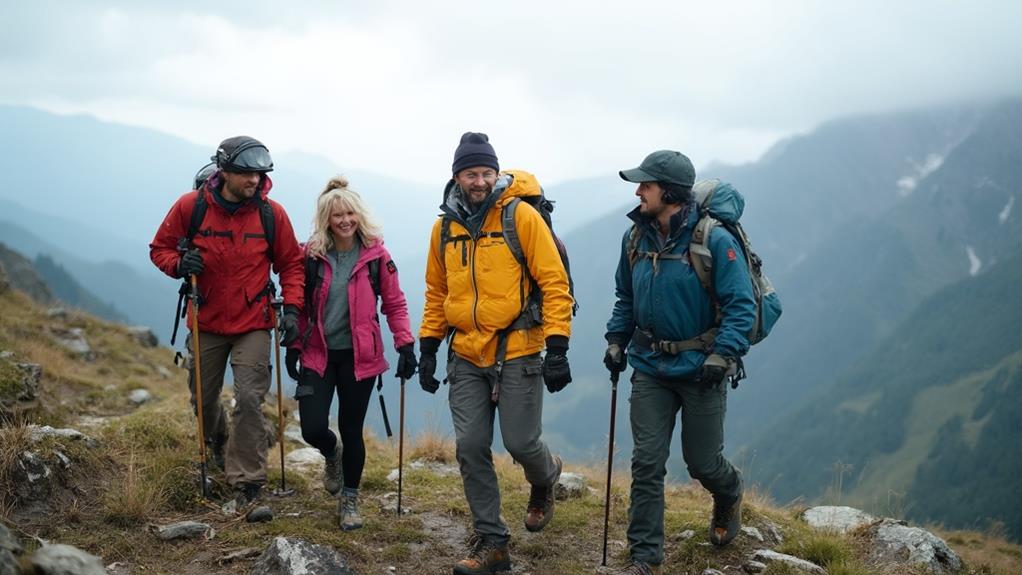
When preparing for a fell walking expedition, the choice of layered clothing is critical for managing comfort and performance.
Start with a base layer made from moisture-wicking materials like merino wool or synthetic fabrics to efficiently manage sweat and regulate body temperature.
Follow this with a mid-layer, such as fleece or a softshell jacket, to provide insulation while maintaining breathability.
Complete the system with a high-quality waterproof outer shell, like those featuring Gore-Tex technology, to guarantee protection against the elements without compromising on ventilation.
Base Layer Selection
Selecting the appropriate base layer is a crucial element for any fell walker aiming to maintain ideal comfort and performance during hikes. A key consideration is moisture management, which hinges on the fabric type used. Merino wool and synthetic fabrics are superior choices due to their moisture-wicking properties. These materials draw sweat away from the skin, keeping the wearer dry and comfortable.
Merino wool, in particular, excels with its natural temperature-regulating and anti-microbial qualities, providing warmth and preventing odors even after prolonged use.
Cotton should be avoided for base layers, as it absorbs moisture and retains it, potentially leading to chilling when temperatures drop—a significant drawback in unpredictable weather conditions. Instead, opt for materials that offer effective moisture management.
The fit of the base layer is equally important. It should be snug yet non-restrictive, enhancing not only moisture management but also overall comfort during movement.
Many brands now offer advanced features like flatlock seams to minimize chafing and strategically placed ventilation zones for increased breathability, particularly in high-sweat areas. Evaluating these aspects guarantees a base layer that effectively supports performance and comfort on the trails.
Insulating Mid Layers
In the domain of fell walking, insulating mid layers serve an essential role in preserving body heat, acting as a key component of the layered clothing system. These layers are crafted from insulating materials that provide exceptional warmth-to-weight ratios, such as fleece and merino wool.
Fleece garments, including microfleece tops, efficiently trap air, creating an insulating barrier that keeps the body warm without adding unnecessary bulk. Similarly, biodegradable merino lambswool jumpers offer natural temperature regulation and comfort, particularly beneficial during prolonged physical exertion in cold environments.
Selecting the right mid layer requires attention to moisture management capabilities. Breathable fabrics are vital to allow perspiration to escape, mitigating the risk of overheating and guaranteeing continuous comfort.
Insulating mid layers should also possess moisture-wicking properties; this feature is important for keeping the skin dry, as retained moisture can lead to chilling and discomfort, especially in colder conditions.
Versatility is another important consideration. Mid layers that can be easily adjusted or removed allow for quick adaptation to the unpredictable weather of fell walking.
This adaptability guarantees that hikers remain comfortable and protected, regardless of fluctuating temperatures encountered during their journey.
Waterproof Outer Protection
Building upon the importance of well-chosen insulating mid layers, the next consideration for fell walkers is selecting effective waterproof outer protection. When maneuvering through the often unpredictable weather conditions of the UK, waterproof technologies become vital. High-quality options, such as jackets made from Gore-Tex or eVent materials, stand out for their dual capabilities of maintaining breathability while ensuring you remain dry.
These materials are engineered with breathable fabrics, enabling moisture from perspiration to escape without allowing rain to penetrate, thereby offering a balanced microclimate for the wearer. The hydrostatic head rating of these materials serves as a benchmark for their waterproof capabilities, with higher ratings indicating superior protection against water ingress.
Layering a waterproof outer shell over insulating mid-layers permits adaptability to varying temperatures, ensuring maximum warmth and dryness. Complementary to jackets, waterproof trousers are indispensable for full-body protection. Features such as adjustable hems and ventilation zips enhance both fit and comfort, allowing for customized wear.
Essential components of this gear category include adjustable hoods and storm flaps, which provide additional coverage. Reflective materials integrated into the design further enhance safety by improving visibility during low-light conditions, making them invaluable for dedicated fell walkers.
Waterproof Essentials
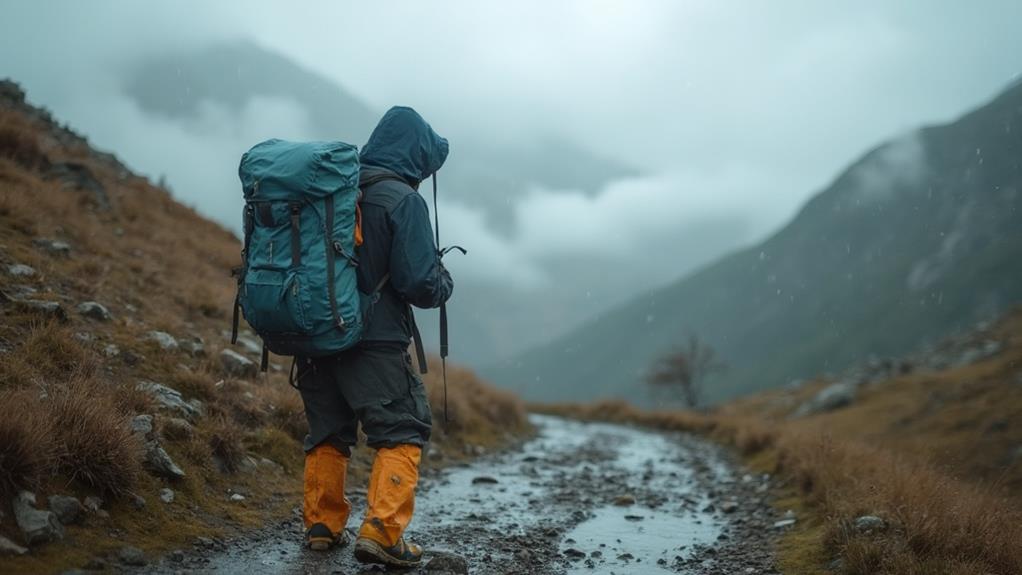
When selecting waterproof essentials for fell walking, understanding the nuances of fabric technology is essential, with options like Gore-Tex and eVent offering superior breathability and durability to keep you comfortable in diverse weather conditions.
Key features to assess include adjustable waistbands and ventilation zippers on waterproof trousers for enhanced comfort, as well as hydrostatic head ratings of at least 10,000 mm to guarantee reliable resistance against heavy rain.
Additionally, gaiters and waterproof stuff sacks not only protect your lower extremities and gear from moisture and debris but also considerably extend the longevity of your equipment.
Essential Waterproof Fabrics
Although outdoor enthusiasts often prioritize comfort, the importance of selecting the right waterproof fabric cannot be overstated for fell walkers traversing challenging terrains. Advanced waterproof technologies such as Gore-Tex and eVent are vital for maintaining dryness while guaranteeing fabric breathability, a key consideration for those engaging in physically demanding activities.
These fabrics are engineered to allow perspiration to escape, thereby preventing the discomfort of condensation build-up, while reliably keeping rain and moisture at bay.
The hydrostatic head rating is a critical parameter when evaluating the effectiveness of waterproof fabrics. A rating of 10,000mm or more is considered sufficient for most outdoor activities, providing robust protection against the elements.
Beyond fabric choice, practical features like adjustable hoods, cuffs, and ventilation options in quality waterproof jackets enhance adaptability and comfort in fluctuating weather conditions.
For fell walkers, waterproof over-trousers are not merely optional but essential, offering additional protection in rugged and unpredictable terrains.
Regular maintenance, such as reproofing with appropriate treatments, can greatly extend the lifespan and maintain the performance of waterproof gear. This guarantees that your investment remains effective, providing continued protection and comfort during your outdoor adventures.
Weather-Resistant Gear Features
Selecting the right waterproof fabric is just the beginning; understanding the features that enhance weather resistance in hiking gear is equally important. Waterproof gear should not only offer high hydrostatic head ratings—preferably above 10,000 mm—but also incorporate breathable materials such as Gore-Tex or eVent. These fabrics are essential as they allow sweat to escape, maintaining comfort without compromising on waterproofing. Confirming that your gear has adjustable features such as hoods, cuffs, and ventilation options is critical. These elements allow for a customized fit and improved airflow, adapting to dynamic weather conditions encountered during fell walking.
Below is a comparison of key waterproof gear features:
| Feature | Benefit | Recommended Brands |
|---|---|---|
| Breathable Materials | Enhanced comfort through moisture management | Gore-Tex, eVent |
| Adjustable Features | Custom fit and adaptability to weather changes | Sprayway, HydroDRY |
| Hydrostatic Head Rating | High-level waterproof protection (10,000 mm+) | Various Premium Brands |
Investing in quality materials such as Sprayway's HydroDRY assures durability and affordability without sacrificing essential protection. To extend the lifespan of your gear, regular cleaning and reproofing are recommended. This maintenance confirms that the gear remains effective against the elements, providing long-lasting performance.
Navigation Tools
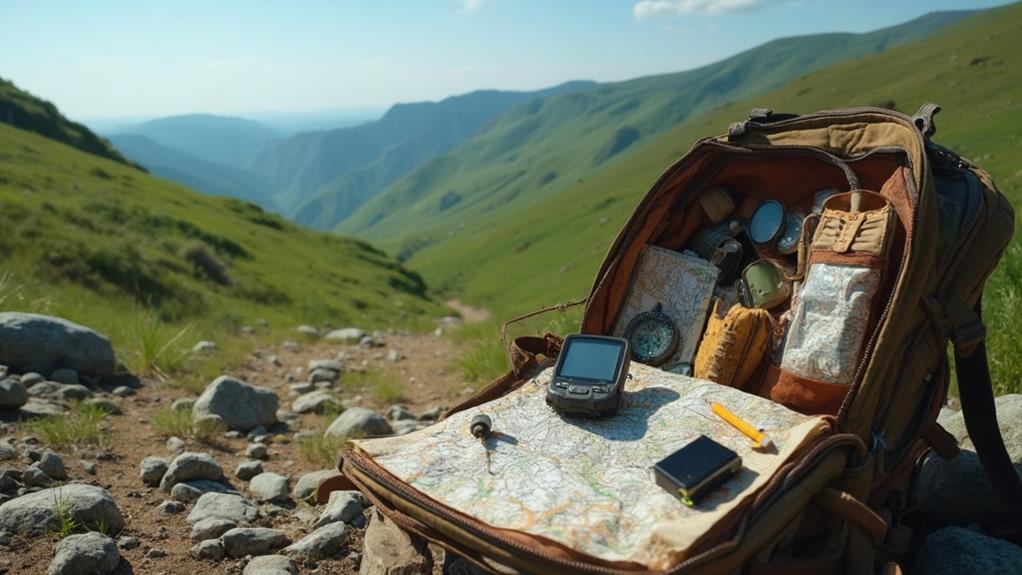
Traversing the rugged landscapes of fell walking requires a combination of traditional and modern tools to guarantee safety and precision. Mastering map reading and compass skills forms the bedrock of effective navigation. Ordnance Survey (OS) maps are indispensable for their detailed topographic information, essential for route planning and terrain awareness.
Complementing these are GPS devices, such as fitness watches and handheld units, which offer real-time location tracking. However, reliance solely on digital tools can be risky due to potential signal loss; therefore, integrating navigation apps with traditional maps is advisable for thorough navigation strategies.
Emergency signaling is a significant consideration for fell walkers. A whistle, often overlooked, is a critical piece of equipment capable of transmitting distress signals over extensive distances, outperforming the human voice in challenging environments. This simple device is an essential companion when technology fails.
For those seeking heightened confidence and safety in the outdoors, acquiring solid navigation skills, including compass use and understanding topographic features, cannot be overstated.
While modern technology provides convenience, the synergy of traditional methods and digital tools guarantees a safe and informed journey across fell walking terrains.
Hydration Systems
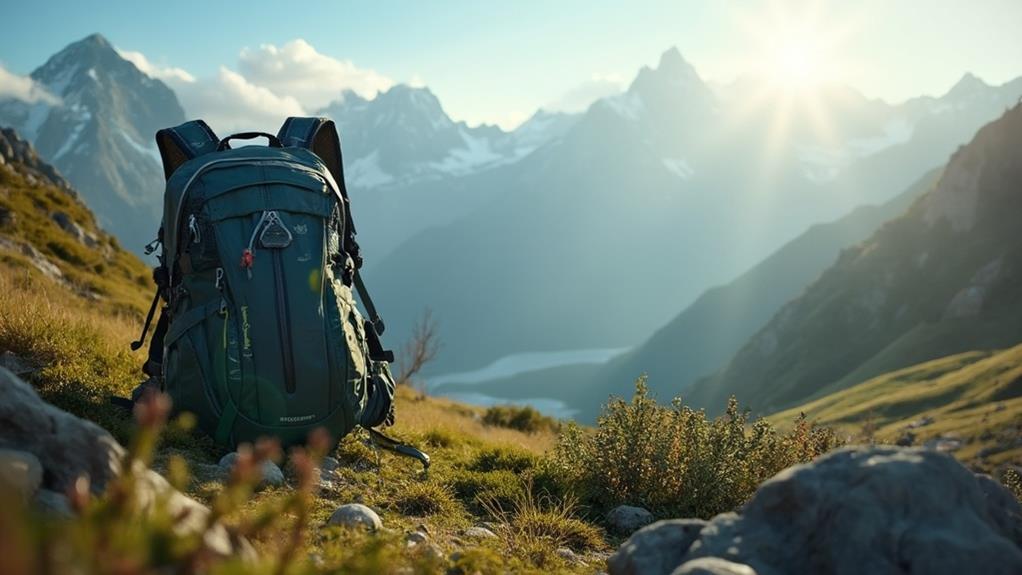
Hydration systems are an essential component of a fell walker's gear arsenal, guaranteeing the maintenance of ideal hydration levels vital for performance in demanding terrains. The choice between hydration bladders and water bottles depends on personal preference and hike duration. For longer treks, a 3-liter hydration bladder is highly recommended, as it offers easy access to water without necessitating frequent stops. This system fits snugly into a backpack, allowing hands-free operation, which is invaluable in tricky terrains.
Practical hydration tips include the need to consume 0.5 to 1 litre of water per hour, varying with conditions such as temperature and exertion level. Hydration packs often feature compartments for snacks and essentials, a boon for those seeking convenience.
However, merely carrying water is insufficient; hikers must also ascertain its safety. Portable water filters and purification tablets are essential, allowing the use of natural sources encountered along the route. This water filtration capability not only reduces pack weight but also guarantees a continuous supply of potable water.
Regular checks and refills during breaks are vital, as dehydration can greatly impair physical performance. Selecting the right hydration system, consequently, becomes a pivotal decision in guaranteeing a safe and enjoyable hiking experience.
First Aid Kit
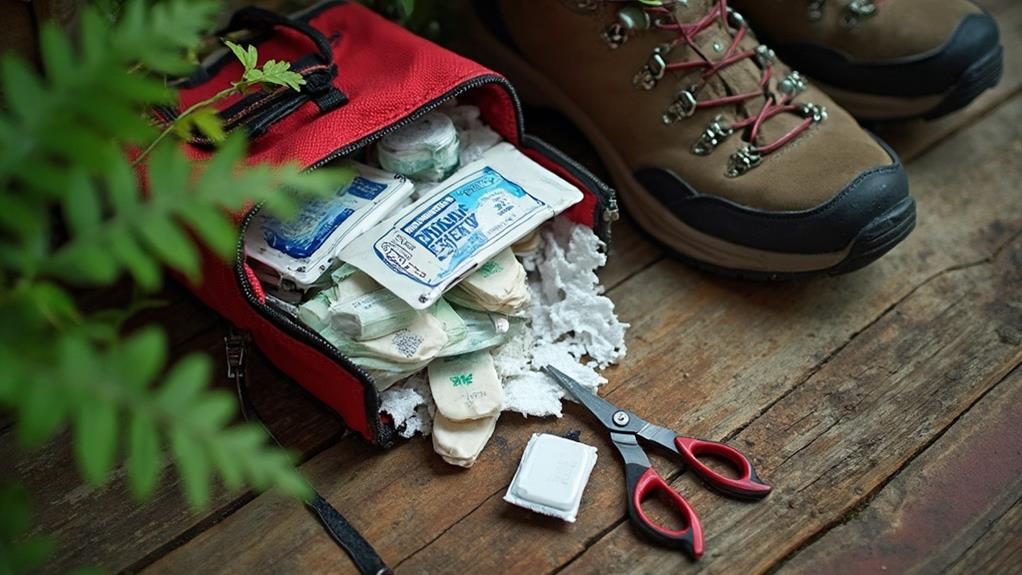
When preparing for a fell walking expedition, a meticulously stocked first aid kit is indispensable, comprising essential items such as blister plasters, antiseptic wipes, and pain relievers to manage common trail injuries.
Incorporating tools like tweezers and scissors, along with personal prescription medications, guarantees thorough care tailored to your specific needs.
Regular maintenance of the kit, including replenishing supplies and checking expiration dates, is vital for maintaining its effectiveness and readiness for any emergency situation.
Essential First Aid Items
For those commencing on fell walking adventures, assembling an extensive first aid kit is essential to ensuring safety and preparedness in the face of potential injuries. A meticulously curated kit is indispensable for hiking injury prevention and outdoor emergency preparedness.
Essential items, like blister plasters, are critical for addressing one of the most common ailments on the trail, allowing hikers to manage friction-induced injuries effectively. Antiseptic wipes and assorted bandages are important for treating minor cuts or scrapes, ensuring cleanliness and protection from infection.
To manage more serious injuries, gauze swabs and microporous tape are necessary for securing dressings on open wounds, providing stability and protection. Tweezers, an often-overlooked tool, are essential for removing splinters or ticks, reducing the risk of infection and Lyme disease. Safety pins serve a dual purpose, securing bandages or temporarily fixing gear.
In terms of medication, including pain relievers such as ibuprofen or paracetamol is advisable for managing pain or inflammation during long treks.
Comparing various first aid kits available on the market, those that offer thorough supplies tailored to hiking-specific needs provide the best value for fell walkers seeking to stay prepared and protected.
Regular Kit Maintenance
A well-maintained first aid kit is akin to a reliable compass, guiding fell walkers through unforeseen medical challenges on the trail. Guaranteeing emergency preparedness begins with routinely inspecting the kit, ideally every few months, to verify that items like antiseptic wipes, blister plasters, gauze swabs, and bandages are within their expiration dates.
Expired items compromise effectiveness and should be replaced promptly to maintain the kit's integrity.
Customizing the first aid kit to accommodate personal needs is vital. This includes accounting for any specific medical conditions or allergies of those in your hiking group. By tailoring the contents, you guarantee that the kit is equipped to handle potential scenarios unique to your needs, enhancing safety and preparedness.
Storage also plays an important role in maintaining the kit's functionality. Utilize a waterproof bag to safeguard the contents from moisture, guaranteeing they remain dry and usable in adverse weather conditions.
Familiarity with the kit's contents and practicing basic first aid techniques are equally important. Such knowledge empowers hikers to respond swiftly and effectively in emergencies, reinforcing the importance of thorough first aid training as an integral part of emergency preparedness for fell walkers.
Daypack Features
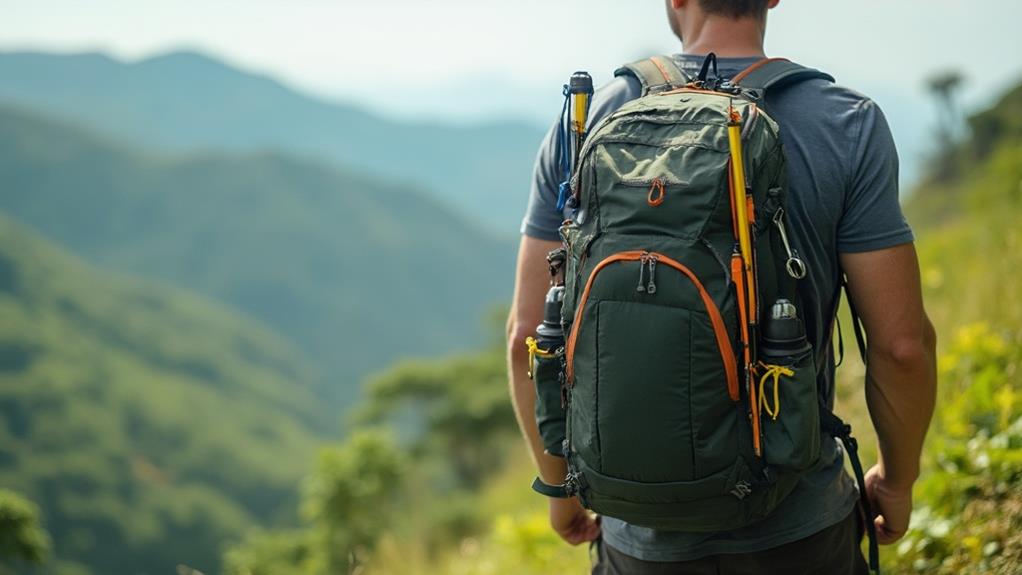
Selecting the right daypack is important for any fell walker seeking a balance between functionality and comfort on the trails. A well-organized daypack with a capacity of 20 to 30 liters is ideal, providing ample space for essentials like water bottles, snacks, and extra clothing layers while maintaining a manageable weight.
Effective daypack organization guarantees quick access to items, which is essential during dynamic weather changes or when energy levels need replenishing. Weight distribution is another important factor. Look for daypacks with adjustable straps and padded back panels, which help evenly disperse weight across the back, minimizing fatigue over extended hikes.
This feature not only enhances comfort but also reduces the risk of strain or injury. For hydration, many daypacks include reservoir sleeves or pockets, allowing for easy water access without interrupting your stride. Ventilation features, such as mesh back panels, are critical for maintaining airflow and reducing sweat buildup, especially during strenuous ascents.
Lightweight, durable materials further augment the practicality of a daypack, making sure it withstands the rigors of outdoor use without adding unnecessary burden. Ultimately, choosing a daypack with these features will greatly enhance your hiking experience, promoting comfort and efficiency on the trail.
Weather Protection
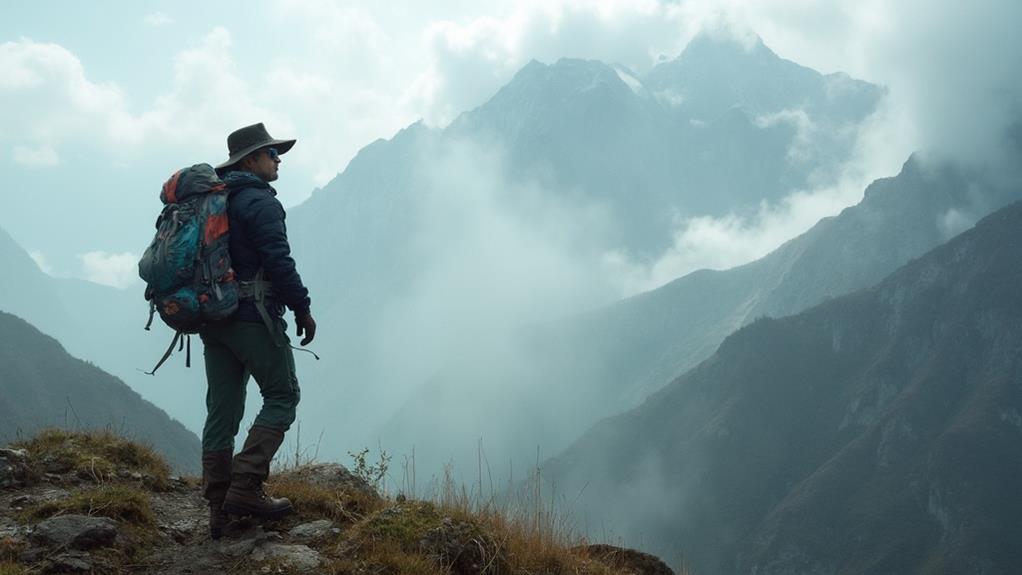
Equipping oneself with the right daypack is just the beginning when preparing for the unpredictable conditions encountered during fell walking. Weather protection is important due to rapidly changing weather patterns, making high-quality waterproof jackets and trousers indispensable. Opt for materials like Gore-Tex or eVent, which offer durability and breathability, important for maintaining comfort and dryness. When choosing a jacket, consider features such as adjustable hoods, ventilation options, and an adequate hydrostatic head rating to guarantee thorough waterproofing.
Layering effectively is another key aspect. A waterproof outer layer should be paired with moisture-wicking base layers and insulating mid layers to optimize warmth and comfort in adverse conditions. This approach not only addresses immediate protection needs but also supports long-term comfort during prolonged exposure to inclement weather.
| Feature | Importance | Recommended Options |
|---|---|---|
| Waterproof Fabric | Durability & Breathability | Gore-Tex, eVent |
| Jacket Features | Effective Waterproofing | Adjustable hoods, vents |
| Layering | Warmth & Comfort | Moisture-wicking, insulating |
Incorporating emergency preparedness into your kit is necessary. Packing an emergency shelter, like a lightweight bivvy bag or foil blanket, offers essential protection against unexpected weather changes, providing an additional layer of security in emergency situations.
Safety Accessories
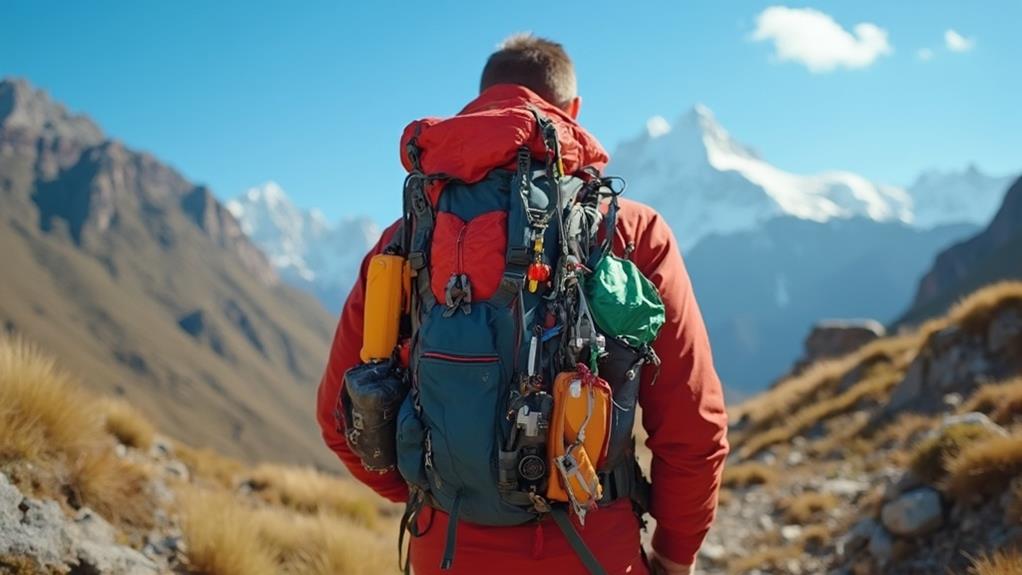
Essential safety accessories are a significant consideration for any fell walker aiming to confirm both personal safety and preparedness in the unpredictable outdoors.
In low-light conditions, a headtorch is indispensable, offering hands-free illumination with adjustable brightness settings. This adaptability guarantees optimal visibility whether traversing trails at dusk or managing campsite duties after dark.
Emergency signaling is facilitated by a lightweight emergency whistle, a compact yet powerful tool. Capable of emitting sounds much louder than a human voice, it is an indispensable device for signaling distress, with the standard protocol being three blasts to alert others to your situation.
A compact survival shelter, such as a bivvy bag, is vital among survival essentials. This portable shelter provides waterproof protection and warmth, essential during unexpected weather changes or emergencies.
Equally important is a hiking-specific first aid kit, containing essentials like blister plasters, antiseptic wipes, and gauze to treat common injuries.
Additionally, gaiters are recommended for their ability to shield the lower legs and footwear from moisture and debris, enhancing safety on rugged trails.
Incorporating these carefully selected safety accessories can make a significant difference in confirming a safe and enjoyable fell walking experience.
Energy Supplies
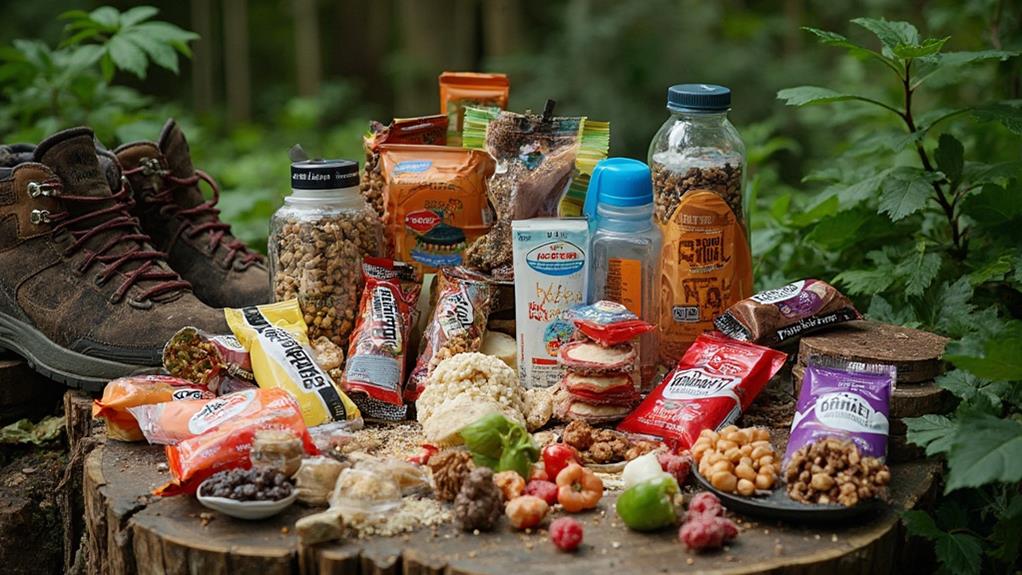
Consistently maintaining ideal energy levels is vital for fell walkers tackling challenging terrains, and selecting the right energy supplies is a key component of this strategy. A well-rounded snack variety is essential; high-calorie options such as trail mix, energy bars, and dried fruits offer rapid energy boosts necessary for strenuous hikes.
To maximize energy timing, it's advisable to consume 200-300 calories per hour, especially on extended treks. This approach guarantees walkers sustain their performance and avoid fatigue.
In addition to solid snacks, hydration plays a significant role in energy maintenance. Replenishing lost electrolytes through sports drinks or electrolyte tablets is vital, as they help sustain hydration and internal balance, particularly during prolonged exertion.
Foods rich in carbohydrates, such as nut butter packets or whole grain crackers, provide a slow release of energy, ideal for challenging and lengthy walks.
For those starting on longer journeys, lightweight, portable cooking equipment, like a compact stove, can be invaluable. This not only permits the preparation of hot meals, enhancing caloric intake, but also boosts morale.
Comparing options, walkers should prioritize gear that balances weight, efficiency, and ease of use to guarantee peak energy management on the trail.
Frequently Asked Questions
What Are the 10 Essential Items?
The essential hiking gear includes navigation tools, hiking clothing, durable boots, first aid kits, hydration supplies, sun protection, headlamps, multi-tools, emergency shelters, and energy-dense snacks, each offering unique functionalities that enhance safety, comfort, and performance in challenging terrains.
What Hiking Gear Is Essential?
For ideal performance and safety, essential hiking gear includes robust hiking footwear for traction and support on challenging terrains, and reliable navigation tools, such as a GPS or map and compass, to prevent disorientation and guarantee route accuracy.
What Should Be in a Hiking Emergency Kit?
A hiking emergency kit should contain first aid essentials like antiseptic wipes and bandages, navigation tools such as a map, a flashlight for visibility, an emergency whistle, a Mylar blanket for warmth, and a multi-tool for versatility.
What Is Something a Hiker Should Always Have Before Going on His First Hike?
Before starting on a first hike, a hiker should always possess a basic understanding of hiking safety and beginner tips. This includes researching trail conditions, selecting appropriate gear, and ensuring reliable navigation tools are part of their equipment.
Conclusion
In summary, successful fell walking necessitates a well-considered selection of gear. Reliable footwear and layered clothing guarantee comfort and adaptability across varied terrains and weather conditions. Waterproof essentials and weather protection are vital for maintaining dryness and safety. Navigation tools and hydration systems enhance orientation and physical well-being. Daypacks with suitable features and energy supplies support effective load management and endurance. Safety accessories provide essential security measures, emphasizing the importance of preparedness and informed equipment choices for best hiking experiences.